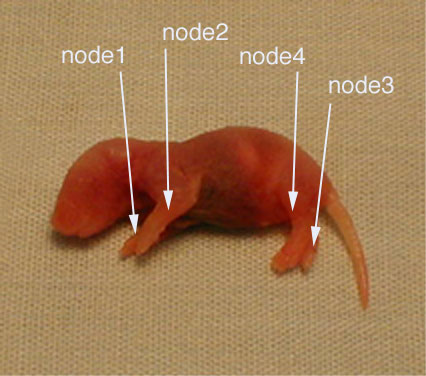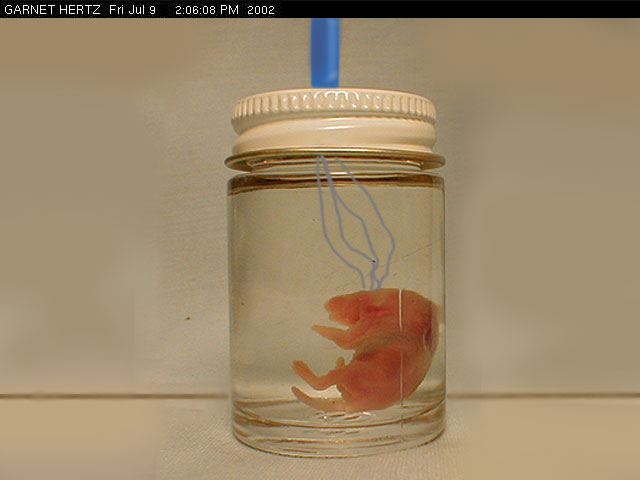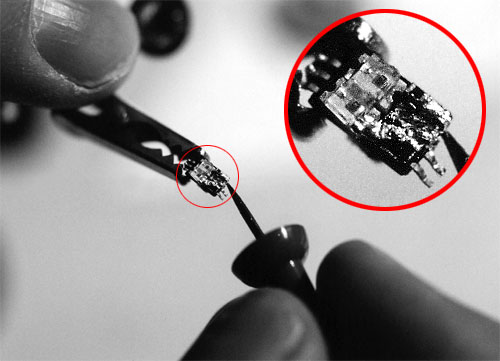Experiments in Galvanism: Networked Chimera (Mouse)
Ace Art: Project Proposal
Garnet Hertz
garnet@conceptlab.com
garnet@vividworks.com
Introduction
This project plans for a miniature computer to be
implanted into the dead body of a mouse specimen. This
computer enables Internet users to trigger physical
"twitching" in the corpse.
This proposal:
- describes the core concept of the project
- explains how the project will be realized
- presents strategies for completion of the project
- identifies theoretical implications of the work in relation to the translocal
- presents a timeline for project completion
- gives a project budget and summary of external funding sources
- references the artist's CV
- includes four (4) work samples that relate directly to this project.
Keywords:
Internet, cybernetics, robotics, corporeality, physical
avatar, suspended animation, visualization of network activity, network topology, miniaturization,
telepresence, bioengineering, biomechatronics, technology
and communication, chimera, Galvanism.
Project Description
Description: Core Concept
The aim of this research is to extend the artist's
previous developments in micro-scale web servers [1]
into
the flesh of a preserved mouse body/specimen. Through the project, web
users (participants) are able to physically "twitch" the corpse through
hyperlinks stored in a series of four (4) microprocessors stored with the body of the cybernetic object.

Figure 1. Implanted network nodes in preserved mouse fetus: one miniature microprocessor per body limb.
Description: Project Realization
This project consists of three primary elements: a
mouse-based robotic object with four miniature computers
implanted into its body, a website which is actually
stored in the memory of each tiny implanted computer, a streaming webcamera observing the entire mouse body, and
a physical installation environment to house the mouse
object for (optional) public viewing.
When operating, this system can be experienced from three
distinct points of view: from the perspective of the implanted networked node (body interior, digital view), from the perspective of a streaming webcam viewing the "meta-mouse" system (body exterior, digital view) and by physically viewing the entire installation (body exterior, physical view).

Figure 2. Proposed view of "meta-mouse" system, exterior to the mouse body, viewed digitally via live streaming webcam. For a live demo of this webcam technology, view http://24.72.34.115/
Physically, the avatar object is suspended in a pool of
formaldehyde solution, and twitches when activated by
users through the implanted web server systems in each leg.
The mouse object will reside in a container
constructed out of glass, and a small hole in the top of the
container will allow the passage of network cables (RJ-45) to the
object.
Digital participants can only animate the mouse avatar in
"twitches": no amount of activation will significantly
mobilize the tethered mouse specimen. Furthermore,
physical viewers of the system have no ability to control or
manipulate the teleoperated device.
Beside viewing the entire mouse system through the streaming webcam, digital users are also able to gain access to the implanted
web servers which reside in the mouse body. This data is accessed through a standard Internet browser or information
appliance that can access a text-based web page: a personal
computer connected to the Internet, a web-browsing
digital telephone, or through a script on the command line
of a server. Furthermore, multiple users can access and
actuate the implanted nodes within object at the same time.

Figure 3. Implanted web content from a single node, actually stored on a microprocessor within the mouse body. Clicking on the "right hind leg" link makes the hind leg of the mouse physically twitch. The processor also collects and displays access data.
The digital participant actually views the website stored
on the implanted web server: when somebody visits the
project website, they are actually digitally residing inside
the corpse of the installation object.
Because of the technical limitations of the server
platform's memory, the system is technically only capable
of holding a few dozen bytes of web page data. This
simple embedded web page displays the word - "node3" - for example,
a link to physically actuate the physical agent, and a
counter that dynamically displays how many visits the
system has received.
By clicking on the link, digital viewers make the mouse
body twitch in the liquid-filled container of the physical
installation.
Description: Project Feasibility
Although I am an emerging artist and the demands of
this project are extensive, I am completely confident that I
will be completed if commissioned. I have done considerable development on this project to date, and have deep
external technical resources and collaborators.
Feasibility: Extensive Development To Date
As a starting point, it is important to note that the most
technically demanding aspect of this project - the
development and operation of the pill-sized micro web
server - is already complete and has already been publicly
exhibited.
[2]

Figure 4. Photograph and detail of
assembled web server prototype built
by Garnet Hertz in 2001.




